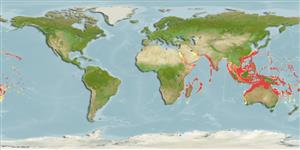分类 / Names
俗名 | 同种异名 | Catalog of Fishes(属, 种) | ITIS | CoL | WoRMS | Cloffa
Elasmobranchii
板鳃亚纲 (鲨鱼与 鱼) (sharks and rays) >
Carcharhiniformes (Ground sharks)
白眼鮫目 (Ground sharks) >
Carcharhinidae (Requiem sharks)
白眼鮫科 (Requiem sharks)
Etymology: Carcharhinus: karcharos (Gr.), sharp or jagged; rhinus, an ancient name for sharks, from rhine (Gr.), rasp, both words alluding to a shark's jagged, rasp-like skin. (See ETYFish); amblyrhynchos: In honor of British zoologist John Francis George Wheeler (1900-1979), former Director of the East African Marine Fisheries Research Organization, whose 1953 account of this shark, as C. amblyrhynchos, is the first definitive record of this species [treated as a junior synonym of C. amblyrhynchos by some workers]. (See ETYFish).
More on author: Bleeker.
Environment: milieu / climate zone / depth range / distribution range
生态学
海洋 礁区鱼类; 海洋洄游的 (Ref. 51243); 深度上下限 0 - 1000 m (Ref. 55178), usually 0 - 280 m (Ref. 6871). 熱帶; 29°N - 35°S, 33°E - 151°W (Ref. 55178)
Indo-West Pacific to Central Pacific: Madagascar and the Mauritius-Seychelles area to Tuamoto Archipelago; north to southern China; south to northern Australia.
印度-太平洋: 馬達加斯加與模里西斯-塞錫爾群島的區域, 可能地印度; 也紅海到南非如果 韋氏真鯊〔Carcharhinus wheeleri〕 是與本種同種異名。 在太平洋, 它範圍從中國南部到澳洲北部與 Tuamoto 列島。
Length at first maturity / 大小 / 重量 / 年龄
Maturity: Lm 128.0, range 96 - 142 cm
Max length : 255 cm TL 雄鱼/尚未辨别雌雄; (Ref. 2334); 172.0 cm TL (female); 最大体重: 33.7 kg (Ref. 4699); 最大年龄: 25 年 (Ref. 37816)
背棘 (总数) : 0; 臀棘: 0. Dark grey or bronze-grey above, white below; caudal fin with a conspicuous wide black posterior margin; undersides of pectoral and pelvic fins with black tips and posterior margins, but fins otherwise not conspicuously black or white-tipped except for white-tipped first dorsal in some individuals (Ref. 9997).
深灰色或青铜色-灰色的上方, 腹面白色的; 尾鳍有一个显着的宽黑色的后缘; 胸鳍下面与腹鳍有黑色顶端与后缘, 但是鳍不一样地不明显的顶端黑色或白色的除了尖端白色的第一背鳍在一些鱼种中.(参考文献 9997)
Occurs on continental and insular shelves and oceanic waters adjacent to them (Ref. 244). Common on coral reefs, often in deeper areas near drop-offs to the open sea, in atoll passes, and in shallow lagoons adjacent to areas of strong currents (Ref. 244). Coastal-pelagic near the bottom, near drop-offs at 1-275 m (Ref. 58302). Forms daytime schools or aggregations in favored areas (Ref. 244). Although active during the day, it is more active nocturnally (Ref. 244). Viviparous, with 1-6 pups (Ref. 37816). Feeds on reef fishes, squids, octopi, crabs, lobsters and shrimps (Ref. 244, 5578). Tends to be aggressive under baited conditions (Ref. 6871) and readily enters into a frenzy feeding pattern, at which time it may become quite dangerous. Repeatedly incriminated in human attacks. Utilized for human consumption, fishmeal, and other shark products. Minimum depth from Ref. 6871. Maximum length of female taken from Ref. 5213.
生活于大陆架与岛屿棚,而且大洋性水域邻近他们。 (参考文献 244) 常见于珊瑚礁, 常见于在海峭壁到开放海域附近的较深的区域中, 在环礁峡谷中, 而且在泻湖浅滩中邻近强水流的区域.(参考文献 244) 在有利的区域中形成白天的鱼群或群集。 (参考文献 244) 虽然活跃的在白天期间,它夜行地更活跃.(参考文献 244) 胎生的,1-6个幼胎.(参考文献 37816) 吃珊瑚礁鱼类,乌贼,章鱼,螃蟹,龙虾与虾。 (参考文献 244,5578) 倾向侵略性在吃东西的情况 (参考文献 6871) 下面与轻易地进入一个狂暴食物, 那时它可能变成相当危险。 重复地牵连在攻击人类。 供人类食用, 鱼粉 , 与其他的鲨鱼产品。 母鱼的最大长度取自了参考文献 5213.
Viviparous, placental (Ref. 50449). 1-6 pups in a litter (Ref. 244). Gestation period about 12 months (Ref. 244). Size at birth 50 to 60 cm (Ref. 26346, 37816) or 75 cm (Ref. 244). Distinct pairing with embrace (Ref. 205).印度-太平洋: 馬達加斯加與模里西斯-塞錫爾群島的區域, 可能地印度; 也紅海到南非如果 韋氏真鯊〔Carcharhinus wheeleri〕 是與本種同種異名。 在太平洋, 它範圍從中國南部到澳洲北部與 Tuamoto 列島。
Compagno, L.J.V., 1984. FAO Species Catalogue. Vol. 4. Sharks of the world. An annotated and illustrated catalogue of shark species known to date. Part 2 - Carcharhiniformes. FAO Fish. Synop. 125(4/2):251-655. Rome: FAO. (Ref. 244)
世界自然保护联盟红皮书 (Ref. 130435)
濒危 (EN) (A2bcd); Date assessed: 03 July 2020
人类利用
渔业: 低经济; 游钓鱼种: 是的
工具
特别资料
下载 XML
网络资源
Estimates based on models
Preferred temperature (Ref.
123201): 17.5 - 29, mean 27.5 °C (based on 4022 cells).
Phylogenetic diversity index (Ref.
82804): PD
50 = 0.5000 [Uniqueness, from 0.5 = low to 2.0 = high].
Bayesian length-weight: a=0.00501 (0.00297 - 0.00846), b=3.13 (2.99 - 3.27), in cm total length, based on LWR estimates for this species & Genus-body shape (Ref.
93245).
营养阶层 (Ref.
69278): 4.1 ±0.5 se; based on diet studies.
回复力 (Ref.
120179): 非常低的, 最小族群倍增时间超过14 年 (tm=7; tmax=25; K=0.05-0.86; Fec=1-6).
Fishing Vulnerability (Ref.
59153): Very high vulnerability (85 of 100).
Nutrients (Ref.
124155): Calcium = 5.22 [1.08, 26.72] mg/100g; Iron = 0.37 [0.09, 1.07] mg/100g; Protein = 22 [19, 24] %; Omega3 = 0.123 [0.051, 0.293] g/100g; Selenium = 56.3 [15.3, 156.2] μg/100g; VitaminA = 40.1 [15.4, 109.4] μg/100g; Zinc = 0.496 [0.237, 0.971] mg/100g (wet weight);
